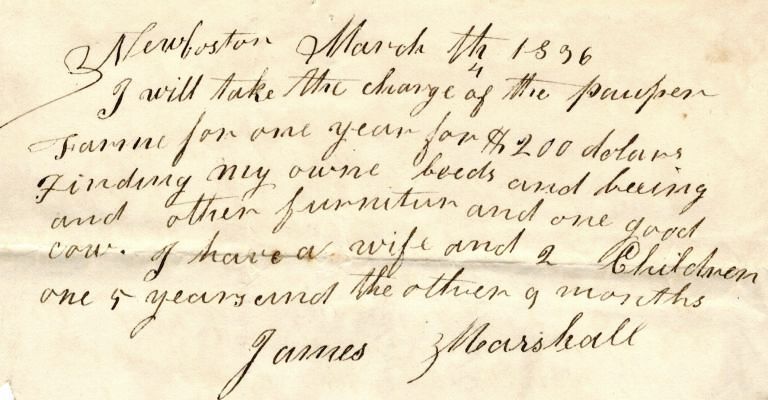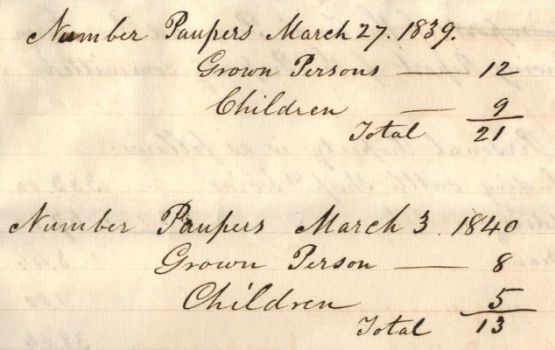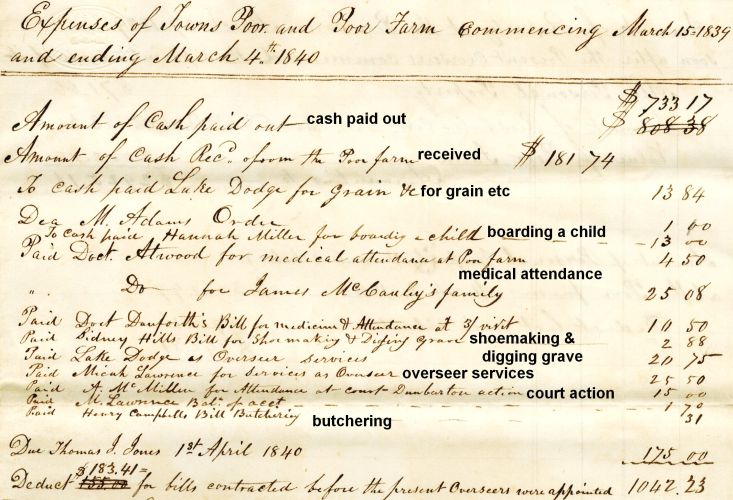New Boston Historical Society
New Boston, New Hampshire

The History of Town Farm Road
from Poor Farm to Fern Valley
You may have seen roads named "Town Farm" or "Poor Farm" in other New Hampshire towns, too. The institution of the Town Farm was an early form of social welfare, where townspeople took reluctant responsibility for neighbors who were old, infirm, or unable to support themselves due to alcoholism or other ailments.
1836-1869 Town Farm
No one wanted to live on a Town Farm. Many stayed only briefly, until they could get back on their feet again or find a distant relative to live with. For example, there were 12 Grown Persons and 9 Children living on New Boston's Town Farm in 1839, but only 8 Grown Persons and 5 Children the next year.
New Boston's Town Farm was established in 1836. Each year the job of Farm Superintendent or Overseer went to whoever submitted the lowest bid, so we may assume that meals and accommodations were not luxurious. Residents helped reduce expenses by growing hay and fodder, peas and beans, corn, and lots of potatoes.

James Marshall's 1836 bid to be Overseer; he requests $200 payment.
"Finding my owne beds and bedding and other furniture and one good cow."

Number of Paupers: Grown Persons and Children

Overseers report 1840

Inventory of the Town Farm 1859
1980s change comes to New Boston
In the early 1980s, Ed Colburn developed the land which had been the Town Farm, creating one of New Boston's first subdivisions, with two dozen house lots including my own. As more subdivisions were built I can imagine the dismay of many townspeople when New Boston's population grew from 1,400 in 1970 to 3,200 in 1990. The silver lining was that most Town Farm houses were built by New Boston carpenters, plumbers, and electricians. A newcomer myself, I was reassured by an editorial in the Union Leader which declared that "Some of us are lucky enough to be born in New Hampshire; others are smart enough to move here."
2020 Fern Valley
What was "Fern Valley"? That is recent history! At the beginning of the COVID-19 pandemic in 2020, one of our New Boston-raised daughters came home to Town Farm Road with her husband and two children when their childcare in the Big City closed. We all self-quarantined for the next 100 days.
Because the New Boston library and playgrounds were also closed, my wife and I didn't know what to do with our one- and three-year-old grandsons, so we walked around Town Farm Road at least once a day, and often twice. One of our neighbors, Donna Peterman, noticed our predicament. She began to hide small plastic toys in the stone wall and ferns alongside the road in front of her house, which was built atop the foundation of the old Town Farm. She made tiny stone walkways, grasshopper-sized doors into tree stump houses, and a ladder of twigs for a toy rabbit. She named her miniature village "Fern Valley."

One of several tableaux in Mrs. Peterman's stone wall
by Dan Rothman — adapted from my column in the October 2020 issue of The New Boston Beacon
